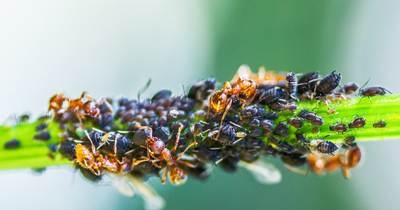|
 The origins of the grape tragedy must be sought in the New World. Europeans conquering America faced wild grapes from the very first steps on the new land. He entangled the trees with a thick net, prevented him from going forward, tempting with berries, large, "like a musket bullet." The origins of the grape tragedy must be sought in the New World. Europeans conquering America faced wild grapes from the very first steps on the new land. He entangled the trees with a thick net, prevented him from going forward, tempting with berries, large, "like a musket bullet."
However the newly minted Americans are wild grapes was of little interest. It was considered that it was more profitable to bring the tested European varieties. They brought it. They were seated. But evil doom hung over the European vine. She died bush after bush. What they did not do! A law was introduced: everyone is obliged to plant 10 cuttings. A prize was appointed. Alas, everything went to pieces. For 150 years, growers have been planting the European vine with desperate tenacity - and with the same result.
 The situation changed only at the beginning of the 19th century thanks to the cunning of the Kentucky Grape Society. There they created several local varieties from wild grapes and passed them off as European ones. By 1818, "European" vines had occupied the entire Atlantic coast. When the deception was discovered, it was too late. However, the consumer began to turn away from the home-grown product, preferring imported European wines. They were overpaid for them twice. The clever French wine merchants did not fail to take advantage of this situation. The situation changed only at the beginning of the 19th century thanks to the cunning of the Kentucky Grape Society. There they created several local varieties from wild grapes and passed them off as European ones. By 1818, "European" vines had occupied the entire Atlantic coast. When the deception was discovered, it was too late. However, the consumer began to turn away from the home-grown product, preferring imported European wines. They were overpaid for them twice. The clever French wine merchants did not fail to take advantage of this situation.
They bought up cheap American wines and then returned them to America under the French brand.
Phylloxera
In this whole story, one thing is important for us: the European vine, for some reason, did not take root on the American mainland. This reason was phylloxera - a tiny aphid that settles on the roots of grapes, bites through the bark and drinks the juice. Viruses penetrate through the wound and complete the death of the bushes.
The losses in the New World, however, were not very large. Much sadder events took place in Europe. The fungus oidium penetrated there from America. And behind him is the phylloxera. In 1868 she settled in France. Six years later - in Germany. And off we go! Twelve years later she arrived in Crimea, and then to Bessarabia.
Tough measures were taken in Crimea. Bushes were uprooted. They burned the vine. The earth was impregnated with carbon disulfide. After that half a century, the pest was not heard. In Bessarabia they tried to do the same. Moaning and crying stood in the Moldavian fields. The writer M. Kotsyubinsky took part in the works and described the tragedy in the short story "For the Common Good". Its plot is simple. A brigade to combat phylloxera arrives in the village. The lot falls on the vineyard of the peasant Zamfar. Luxurious bushes fall under the ax. They saturate the ground with poison. Zamfar's wife comes running. “Where is the aphid? Show!" But the aphid is too small. It is not visible to the naked eye. The woman rips off the bark with her teeth in a frenzy. The bark is poisoned. The unhappy woman dies. The family is broke.
However, such harsh measures were not carried out everywhere. Phyloxera survived. A hundred years have passed. Science went ahead, but it was not possible to defeat the aphids. However, there was hope when the Frenchman J. Planchon suggested grafting the European vine on American roots. The general jubilation began. A monument was erected to the Planchon. On it the inscription: "The American vine gave life again to the French and triumphed over the phylloxera!" Alas, if that were so!
I foresee the question: why was it not possible to solve the phylloxera problem? Well, first of all, grafting a vine on American roots is a troublesome and expensive business. And the grapes from such combined plants will no longer be the same! He will lose a little in taste, in aroma. Therefore, not all vineyards are now created according to the Planchon idea. About half are self-rooted.
How do you manage to save them from aphids? The same as before. The vine is protected with poisons. And although she is doomed, she will live another twenty years. And over the years, it will give another marketable product. However, the vaccination itself is not always a guarantee against the pest.
In general, the winegrowers were divided into two camps. Some - for grafted grapes, others - for their own rooted. Both have their own reasons. The first say: in fifty years, while the grafted bushes are working, the rooted ones will die three times. Even if treatment is carried out twice a year, it will last forty years, but how polluted the air and the soil! The second object. In general, a dispute!
There was, however, a third way. Golden mean. Workers at the Odessa Experimental Station noticed that among the sea of dying bushes, several healthy ones remained. They calculated: if you select these unique specimens and repeat the operation two or three times, you can breed stable offspring. On their own European roots!
Grapes in the north
It is remarkable, however, that phylloxera is not rampant everywhere. In the north, on the Don, it seems that one does not even hear about it. Fortunately, the famous Russian scientist I. Michurin created varieties that grow near Kaluga, and near Moscow, and even in Kalinin ...
 Victory over the climate? Alas, not quite so. Grapes grow in the north, but how? Only experienced. From enthusiasts. Several bushes. With special care. There is no need to dream of large vineyards. Even in sunny Burgundy (where the famous Burgundy!) And there grapes fail once every ten years. Or even twice. Victory over the climate? Alas, not quite so. Grapes grow in the north, but how? Only experienced. From enthusiasts. Several bushes. With special care. There is no need to dream of large vineyards. Even in sunny Burgundy (where the famous Burgundy!) And there grapes fail once every ten years. Or even twice.
The northernmost islet of the chilly creature is somewhere near Berlin, at 53 degrees north latitude. But even in these "northern" areas one has to choose either the southern slope or the warm sandy soil. Or plow with earth. True, the Russian climatologist A. Voeikov argued that in the north, a long day compensates for the lack of heat in grapes. It is true, it compensates. But this compensation only leads to increased growth of shoots. And you need just the opposite.
Therefore, if grapes ripen in high latitudes, then their berries are of inferior quality. An admirer of northern viticulture G. Gogol-Yanovsky passionately wanted to meet a sweet product in our middle zone. I came to Kiev, to Saratov. I tore bunches. Alas, the berries were always like in Krylov's fable - sour. Came the next year. A year later. And further. And each time he was told: "This is a bad year." He did not remember the successful ones.
Does grapes heal?
There are a lot of problems with grapes. One of them is curative. There is such a term - ampelotherapy. Treatment with grapes. But what and how grapes heal, while science does not know for sure. Let me give you one example.
Famous lone sailor William Willis once rented a farm in California. The farmer neighbor had a large vineyard. Willis comes to a neighbor one day, and he sits under a bush, yellow and haggard.
- Cancer, - said the wife. - There is no salvation.
“Yes,” Willis said. - I heard that earlier in Russia they were treated with grapes. The disease did not go away, but it stopped developing.
- What is needed for this? - the neighbor perked up. - Eat a bunch of grapes every day?
- This is not enough. You have to give up everything. No tea, no coffee, no tobacco. One grape. And then years will pass - and they will come up with something ...
We do not know the end of this story. Willis drowned on his third voyage across the Atlantic. And now there is no one to ask. After all, there are grapes and grapes. There are many varieties of it. Maybe one of them helped?
A. Smirnov. Tops and roots
|
 The origins of the grape tragedy must be sought in the New World. Europeans conquering America faced wild grapes from the very first steps on the new land. He entangled the trees with a thick net, prevented him from going forward, tempting with berries, large, "like a musket bullet."
The origins of the grape tragedy must be sought in the New World. Europeans conquering America faced wild grapes from the very first steps on the new land. He entangled the trees with a thick net, prevented him from going forward, tempting with berries, large, "like a musket bullet." The situation changed only at the beginning of the 19th century thanks to the cunning of the Kentucky Grape Society. There they created several local varieties from wild grapes and passed them off as European ones. By 1818, "European" vines had occupied the entire Atlantic coast. When the deception was discovered, it was too late. However, the consumer began to turn away from the home-grown product, preferring imported European wines. They were overpaid for them twice. The clever French wine merchants did not fail to take advantage of this situation.
The situation changed only at the beginning of the 19th century thanks to the cunning of the Kentucky Grape Society. There they created several local varieties from wild grapes and passed them off as European ones. By 1818, "European" vines had occupied the entire Atlantic coast. When the deception was discovered, it was too late. However, the consumer began to turn away from the home-grown product, preferring imported European wines. They were overpaid for them twice. The clever French wine merchants did not fail to take advantage of this situation.









